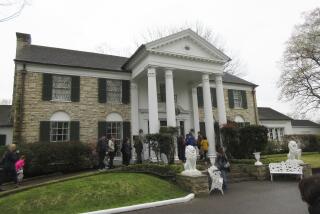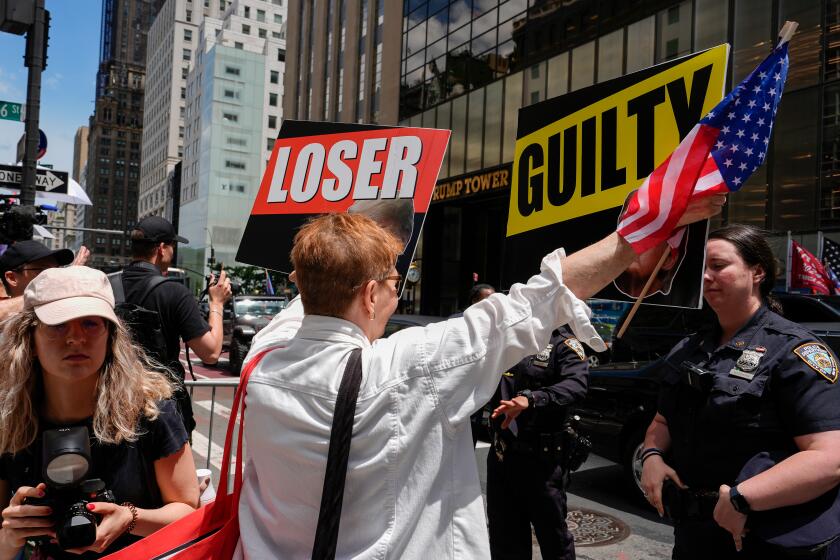PERFORMING ARTS : Music in All the Right Places : Da Camera Society founder MaryAnn Bonino is a nonstop cheerleader for chamber music--in the proper venue.
In a town crawling with producers, agents and wheeler-dealers of all kinds, MaryAnn Bonino is one of L.A.’s most successful matchmakers, bringing together not just people or projects but whole art forms.
As the founding director of the Da Camera Society of Mount St. Mary’s College, she’s the brains--and heart--behind one of the city’s longest-running concert series, “Chamber Music in Historic Sites.” It’s a calling she pursues with an almost missionary zeal, not just for the music she presents--small-group classical, jazz and early music--but for the buildings she presents it in and the story those buildings tell about Los Angeles.
“Part of what we’re about,” she says, “is to give people a different idea of what our city is, what resources are here. They’re spread out, but they’re worth tracking down. And they’re worth experiencing with music. It’s one thing just to take a tour of a place; it’s another to sit in a building and feel it come alive. That’s what our contribution is--to bring it to life.”
Bonino has been matching music and venues since establishing the Da Camera Society in 1973 ( da camera is shorthand for the Italian musica da camera , or chamber music) . Bonino inaugurated the organization with a series of concerts by local chamber groups at the Doheny Mansion on Mount St. Mary’s downtown campus. She expanded its mission as part of the L.A. bicentennial celebration in the 1980-81 season to include sites from all over the city--beautiful, historic, eccentric, dramatic buildings (and in some cases private homes)--that most of us just drive past every day.
One such building is St. Cecilia’s Church, on Normandie near 42nd Street, where the French vocal group Ensemble Organum will make its Los Angeles debut with a “Sites” program titled “Old Roman Chant From the 7th to the 13th Centuries” today at 3 p.m.
Sitting in the rectory of the 1927 cathedral, Bonino points out why she chose this setting for Ensemble Organum’s music. The church’s architectural union of Lombard Romanesque and Byzantine elements, she says, provides the perfect counterpart--”acoustically, visually and spiritually”--to the Latin, Greek and Middle Eastern blend of the group’s musical sources.
“There’s no one else doing what she’s doing,” says Ensemble Organum’s manager Jon Aaron, who has been bringing his artists, among them early-music stars Sequentia, Tallis Scholars and Hesperion XX, to Bonino for the past 14 years. “She has gotten people around the country thinking about more acoustically relevant space. For Ensemble Organum, the standard concert hall was not an option. They perform sacred music, which requires a special acoustic, and I know with MaryAnn, they will also get the proper architectural environment.”
For the 1995-96 season, Bonino has arranged 25 sonic-spatial marriages, including Joel Cohen and the Boston Camerata in a medieval Christmas concert at Pasadena’s Gothic Westminster Presbyterian Church; veteran jazz players the Elders improvising against the 1930s elegance of the Queen Mary; Bulgarian pianist Mario Grigorov performing his classical-jazz crossover music at the swanky, burnished Rex il Ristorante in the Oviatt Building downtown, and a program by Just Strings featuring the Asian-influenced music of Henry Cowell and John Cage at the Sabella House in San Marino, a private residence full of Asian art and artifacts.
“I try to put together as good a mix as I can,” Bonino says of the music. “I look for the best performers and for balance: established artists with new talent, familiar repertory with less well-known, string quartets with other genres such as jazz, choral and chamber orchestra.”
Venue selection at first took up a lot more time than it does now; there was so much to chose from.
“I was a dangerous driver for a very long time,” Bonino says with a laugh, “because I was looking, not at the road ahead, but at the buildings around me.”
Two decades later, such spaces as Union Station, the Biltmore Hotel Crystal Room and the trusty Doheny Mansion have become regular stops on the Da Camera circuit, and some private residences are on their second or third go-round. One homeowner coming back for more is Rick Ross, whose minimalist, high-tech Malibu house with a huge Pacific Ocean view was the scene for an especially appropriate performance last year of George Crumb’s “Voice of the Whale” by a local ad hoc ensemble, the Da Camera Players.
“The pianist plucked the strings and the cellist and flute player made noises which came together to sound like whale calls,” he recalls. “It was a great experience to listen to that and look out at the ocean. The audience was transfixed.”
Sites are often provided free or for nominal charges, Bonino says. “We’ve found people to be very generous because it’s a one-time thing, and they make a contribution to the community.” The concerts are also underwritten through memberships in the Da Camera Society, ticket sales, grants and administrative support from Mount St. Mary’s.
Bonino, who introduces and emcees all the shows, is a Los Angeles native, a Mount St. Mary’s College professor at large, a musicologist who holds a doctorate from USC and an indefatigable cheerleader for serious music. She waves her hands and shakes her mane of curly blond hair as she speaks about the program. The “Sites” idea, she says, came from her experiences studying in Europe, where performances are routinely staged in the churches, castles and homes they were originally written to be performed in.
“It seemed to be a more congenial experience, to work better than in a large auditorium, because of the social atmosphere, the fact that the musicians were just an arm’s length away from you,” she says. “This is the atmosphere in which chamber music was born.”
As it turned out, Los Angeles proved to share Bonino’s appetite for that congenial experience. The series expanded through the years until 1992, when the Da Camera Society was presenting 50 concerts a year and had a full-time staff of eight. Then Bonino decided to downsize: “We wanted to spend less time on marketing, more time on programming.”
Now, with half the peak number of concerts and a staff of three, she thinks the series is more manageable--or at least more fun to manage. Marketing almost takes care of itself: The core “Sites” audience signs up as members of the Da Camera Society and series subscribers. As usual, the concerts in private homes--which are much in demand and where seating is very limited--sold out early this year. Tickets to events in the bigger venues are still available.
“We have a very curious and experimental bunch of people in Los Angeles, and that’s why we’ve been successful here,” Bonino says. “I think that we are eager to find roots and tradition in our city, and whatever provides focus for that need--a music performance here and there will do that--is something that people welcome and are glad of.”
*
CHAMBER MUSIC IN HISTORIC SITES,”Old Roman Chant From the 7th to the 13th Centuries,” Ensemble Organum, St. Cecilia’s Church, 4320 S.
Normandie Ave. Date: Today, 3 p.m. Pre-concert lecture, 2:15. Prices: $18-$27. Information: For a complete “Sites” schedule and membership information, contact the Da Camera Society, Mount St. Mary’s College, 12001 Chalon Road, Los Angeles 90049; (310) 440-1351.
More to Read
The biggest entertainment stories
Get our big stories about Hollywood, film, television, music, arts, culture and more right in your inbox as soon as they publish.
You may occasionally receive promotional content from the Los Angeles Times.






